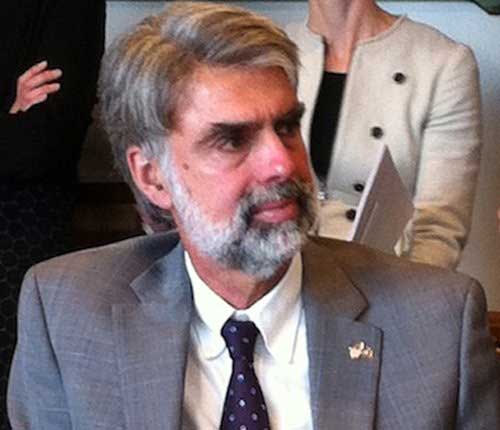NVU takes a 15 percent hit under new funding formula

Jeb Spaulding
At the end of September, the Vermont State Colleges Board of Trustees approved a recommendation from the board’s Finance and Facilities Committee that changes allocation of state appropriation funding within the VSCS, changes that mean NVU will lose 6.1 percentage points or approximately 15 percent of its state funding annually.
The old appropriations formula was set up so that all five institutions within the VSCS (Johnson, Lyndon, Castleton, VTC and CCV) each received 20 percent of the state appropriations. Thus, it was a totally equal distribution of funds.
Because Johnson and Lyndon have now become one university, there are only four institutions within the VSC system instead of five. Under the old formula, that would have meant NVU would have received only 25 percent, compared to the 40 percent they had been getting as two separate institutions, something the board realized would be untenable.
After long debate, it was determined that the prudent action would be to reduce NVU’s chunk of the state appropriation for the VSCS to 33.9 percent.
Under the new formula, according to a memorandum to the Finance and Facilities committee from VSCS Chief Financial Officer Steve Wisloksi, the overall negative change for NVU over four years will be $418,710 annually compared to the long-standing old formula.
As a result of this reallocation formula, Castleton will see an increase of 5.4 percentage points in its funding, a 25 percent increase that translates to an additional $1.5 million annually.
VTC saw a 3.5 percent increase in its budget, while CCV remained at level at 20 percent.
“My sole mission as Chancellor is to make sure that all four institutions are on a more secure financial footing than they were when I got here,” Chancellor of the Vermont State Colleges System Jeb Spaulding said, adding that the new formula is an attempt to be fair to all VSCS institutions.
Nevertheless, the implications of this formula are problematic for NVU.
A “disappointed” NVU President Elaine Collins knows that the decision will place additional burdens on the new university and the substantial progress it has made in her four-year stint as a VSCS president.
“I am not going to say it is not concerning. Anytime that we are adding a deficit to something we are trying to build up is an issue,” Collins said.
With Johnson and Lyndon having relied on the earlier formula for as long as they did, the cut in allocation will put additional pressures on the nascent university.
However, the argument that NVU should still receive 40 percent of the VSCS appropriations because it has two major campuses has been rejected by the board of trustees chairman, Churchill Hindes.
“We see NVU as a single university with two campuses,” he said. “NVU is not our only institution with two campuses. Vermont Tech has two. By that argument, we should have given VTC more.”
The board’s decision has caused concern among many faculty at NVU.
“I just hope that we’re not setting ourselves up for some kind of situation five years down the road that if NVU is to continue to flourish, we would have to close one of the campuses,” said Professor of Writing and Literature and NVU-Johnson Faculty Assembly chair Tyrone Shaw. “That would be devastating on multiple levels for this state. The loss of either one of them would be seriously deleterious not only to regional health but I think to the state as a whole. That said, the board stated a clear commitment to maintaining a two-campus NVU, as well as a promise to review the new formula as it takes effect, and if changes are needed, they will happen. While I wish the decision had been different, I appreciate the pressures under which they have been working, and these assurances are both welcome and important.”
The fairness issue among the VSCS institutions began long before the creation of NVU. “My historical understanding of this is that, in the past… Castleton did not grow in the way that they wanted it to grow (as a result of previous state appropriations formula). So I think that what happened was when there was this new opportunity to revisit the formula, it was an attempt to stabilize what had been done in the past,” Collins said.
Castleton’s assertion that they had been disadvantaged under the old formula was clearly on the minds of the trustees during their work to revise the allocation formula. “For years Castleton was saying they were getting ripped off here. I have to look out for the best interests of all the colleges,” Spaulding said.
Moving past the Castleton situation, NVU now needs to compensate for a substantial reduction in state funds. This leaves NVU with basically three options according to Collins.
The first is to increase degrees conferred by creating more opportunities for people to enter the university. The second is to increase revenue by acquiring and retaining more students. The third is to hope that the state designates more money toward higher education.
For Shaw, that third option is essential. “We have reached a point where if the viability of this state college system is going to be maintained, the Legislature is going to have to figure out a way to invest more money in this system,” Shaw said. “Remember there is a statute on the books that requires the Legislature to fund the Vermont State Colleges either entirely or substantially. They have been derelict in that for
years, and it’s getting to the point where we’re going to run out of options. We’re at the very bottom of state support for higher education in the United States. We have cut, and we have cut, and we have cut. I would hate to see a situation somewhere down the road where one could say the operation was a success but the patient died.”
Collins “doesn’t know” what the path looks like to get more funding from the Legislature, but assured that she will continue to have conversations to find a potential solution. What she has found is that the state keeps referring her back to traditional ways of coming up with additional funds.
According to Collins, these traditional ways involve the state taking money out of other state-funded educational endeavors such as the University of Vermont, and VSAC, rather than searching for potential new outlets.
Referring to both UVM and VSAC as “sacred cows,” Collins said, “These are good institutions that do good things for people, so it is hard for me as an educator to say, ‘yeah you should take money out of this pot and give it to me.’ What I think should be done is that more money needs to be directed from the state level that is not currently used in education.”
Should none of the three proposed Collins solutions be successful, the new formula can always be revisited and adjusted said Hindes, repeating assurances the board gave when adopting the new formula.
“We will not put a member institution into financial jeopardy. That is the bottom line,” he said.



